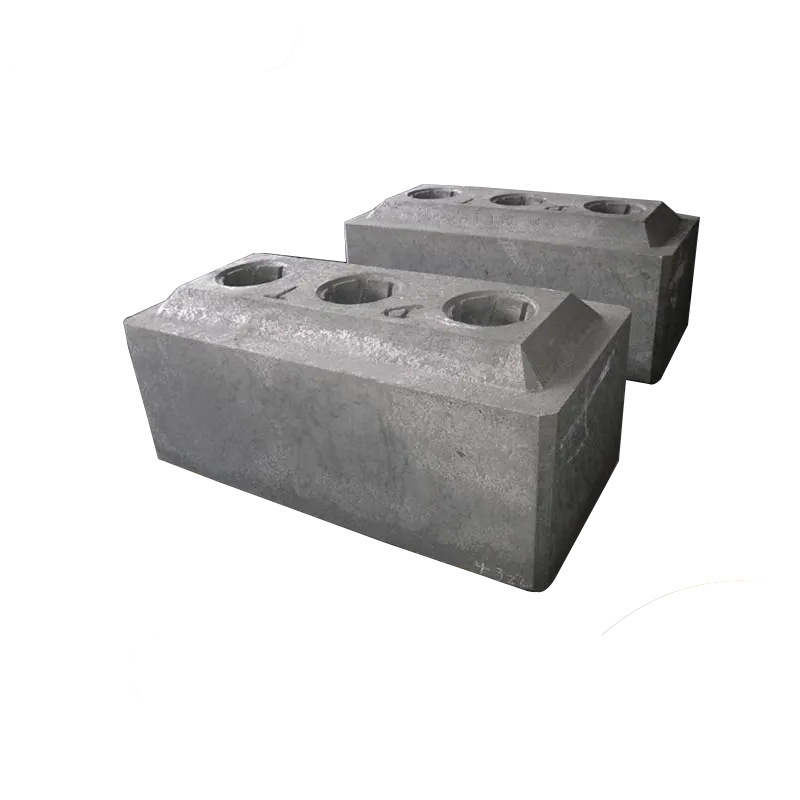The world of industrial metallurgy, particularly aluminum production, is a marvel of modern chemistry and engineering. At the heart of this process lies a critical component: the carbon anode. For anyone involved in sourcing materials for steel mills or foundries, like my friend Mark Thompson in the USA, understanding why these anodes have to be replaced regularly is not just a technical detail—it’s key to managing costs, ensuring quality, and maintaining a smooth production schedule. This article will demystify the electrochemical process, explain the vital role of the carbon anode, and provide clear insights into why its consumption is a necessary and planned part of creating the aluminum that builds our world.
What Exactly is a Carbon Anode and Why is it Essential for Aluminium Production?
Let’s start with the basics. In any electrochemical cell, you have two electrodes: a cathode (the negative electrode) and an anode (the positive electrode). A carbon anode is a large block, typically made from petroleum coke and coal tar pitch, that serves as the positive electrode in the electrolysis process used for aluminum production. Think of it as a giant, purpose-built carbon electrode designed for a very specific and demanding job. Its primary function is to conduct a massive electrical current into the electrolytic bath where aluminum is made.
The importance of the carbon anode cannot be overstated. It is a cornerstone of the Hall-Héroult process, the only method used for mass-producing aluminium today. Without a high-quality anode, the entire process would be inefficient or fail altogether. The anode introduces the electricity needed to break down alumina (aluminum oxide), but as we’ll see, it does much more than that. It actively participates in the chemical reaction, which is the very reason it must be replaced regularly. The quality of the anode material directly impacts the purity of the final aluminium and the overall energy efficiency of the smelting operation.
How Does the Electrochemical Process in Aluminum Smelting Work?
Imagine a large container, or "pot," lined with carbon, which acts as the cathode. This pot is filled with a molten bath of cryolite, a mineral that has a lower melting point than alumina. Alumina (Al₂O₃), a white powder extracted from bauxite ore, is then dissolved into this bath. The large carbon anode blocks are lowered into this superheated mixture from above. When a powerful direct current is passed through the cell—from the anode to the cathode through the electrolyte—the magic of electrolysis begins.
This electrical current causes the alumina to split apart. Positively charged aluminum ions (Al³⁺) are attracted to the negative cathode at the bottom of the pot. Once they reach the cathode, they gain an electron (or three, to be precise) and become pure, liquid aluminium. This molten metal then pools at the bottom of the pot, where it is periodically siphoned off. At the same time, negatively charged oxide ions (O²⁻) are attracted to the positive carbon anode. What happens next is the key to our main question. This electrolysis process is a continuous dance of ions and electrons, driven by electricity to produce one of the most useful metals on earth.

Why is Carbon the Chosen Anode Material for This Process?
You might wonder, why use a carbon anode if it gets consumed? Why not use an inert anode that doesn’t react? The reasons are a perfect blend of chemistry and practicality. First, carbon, especially in its graphite form, has excellent electrical conductivity, which is essential for carrying the immense currents required for electrolysis with minimal energy loss. Second, carbon can withstand the extremely high temperature (around 950°C or 1742°F) inside the electrolytic pot without melting; its boiling point is incredibly high.
Most importantly, the chemical reaction of carbon with oxygen is actually beneficial. During the electrochemical reaction, the oxygen released from the alumina needs to go somewhere. By having it react with the carbon anode, the process effectively removes the oxygen as carbon dioxide gas. This oxidation reaction helps drive the overall process and actually lowers the amount of energy needed to break apart the alumina compared to using an inert anode. So, while the anode is consumed, its sacrifice makes the entire aluminum production process more energy-efficient and economically viable. The anode material is not just a tool; it’s an active ingredient.
What Happens to the Carbon Anode During the Production Process?
During aluminum production, the carbon anode is more than just a passive conductor of electricity. It’s an active participant in the chemical reaction, a consumable component that gets used up over time. As the electrolysis process breaks down alumina into aluminium and oxygen, the negatively charged oxygen ion is drawn to the positively charged carbon anode.
When the oxygen ions reach the surface of the hot anode, a powerful oxidation reaction occurs. Each carbon atom on the surface of the anode eagerly combines with the oxygen atoms. This reaction forms gases, primarily carbon dioxide (CO₂) and sometimes a small amount of carbon monoxide. Because the anode is made of carbon, and this carbon is turning into a gas and floating away, the anode itself is literally being eaten away. It gets smaller and smaller, and its surface becomes pitted and uneven. This consumption is a fundamental, unavoidable part of the Hall-Héroult process. The anodes are consumed at a predictable rate, a factor that smelters must calculate into their operational plans.
Why is the Regular Replacement of the Anode a Critical Step?
Since the carbon anode is continuously consumed, its regular replacement is not just recommended; it’s an absolute necessity. As the anode shrinks, the distance between it and the molten aluminium at the cathode changes. This gap is critical for maintaining a stable and efficient electrolysis process. If the gap becomes too large, the electrical resistance of the cell increases, forcing the smelter to use more energy to produce the same amount of aluminium, which drives up costs.
Furthermore, as the anode wears down, its shape becomes irregular. This can lead to uneven current distribution, causing inefficiencies and potentially affecting the quality of the final product. To maintain optimal performance, the spent or partially consumed anode butts are removed, and fresh ones are installed. This cycle ensures that the electrolytic cell operates within its designed parameters. Therefore, the anodes have to be replaced on a strict schedule to ensure a consistent, high-quality, and cost-effective aluminum production process. It’s a core part of the maintenance routine in any smelter. This is why a reliable supply of components like high performance pre baked anode carbon blocks is so crucial for operators.

What is the Chemical Reaction that Consumes the Anode?
Let’s look a little closer at the chemistry. The whole event is an oxidation-reduction reaction. The alumina (Al₂O₃) dissolves to release Al³⁺ and O²⁻ ions. At the cathode, reduction happens:
- Al³⁺ + 3e⁻ → Al(l) (Liquid aluminum is formed as each aluminum ion gains three electrons)
At the carbon anode, oxidation happens. The oxygen ions give up their extra electrons and react with the carbon atom of the anode:
- 2O²⁻ + C(s) → CO₂(g) + 4e⁻ (A carbon atom from the solid anode reacts with two oxygen ions to form carbon dioxide gas, releasing four electrons)
This is the primary reaction that consumes the carbon electrode. The carbon literally transforms from a solid part of the anode into carbon dioxide gas and bubbles away. For every kilogram of aluminium produced, roughly 400-500 grams of the carbon anode are consumed in this oxidation reaction. This is a significant amount, illustrating perfectly why a massive, continuous supply of anodes is required and why they need to be replaced regularly.
How Does Anode Quality Affect the Aluminum Production Process?
Not all carbon anodes are created equal. As a procurement officer like Mark knows, quality is paramount. The quality of the anode material has a direct and significant impact on the efficiency and cost of aluminum production.
| Feature | High-Quality Anode | Low-Quality Anode |
|---|---|---|
| Purity | Low ash and sulfur content | High impurity levels (ash, sulfur) |
| Density | High, uniform density | Low, inconsistent density |
| Conductivity | High electrical conductivity | Lower electrical conductivity |
| Reactivity | Optimal reactivity for efficiency | Too high or too low, causing issues |
| Strength | High mechanical strength | Prone to cracking and dusting |
A high-quality carbon anode with high purity and uniform density leads to lower energy consumption because its superior electrical conductivity reduces resistance. It also consumes more evenly, extending its useful life and producing less waste. Conversely, a poor-quality anode with impurities can introduce contaminants into the aluminium, lowering its final value. It may also have higher electrical resistance, demanding more energy, and can be prone to cracking under the high temperature and mechanical stress of the electrolytic cell, leading to operational disruptions. For products where purity is critical, using high-grade materials like high purity 99.9% graphite powder in the manufacturing of specialty carbon products is a must.

What Are the Consequences of Not Replacing an Anode on Time?
For a smelter, delaying the replacement of a carbon anode is not a viable cost-saving measure; it’s a recipe for operational problems. The consequences can be severe and costly. First, as the anode gets too small, the process efficiency plummets. The voltage required to run the cell increases dramatically, leading to wasted electricity and soaring energy bills.
Second, the risk of what’s known as an "anode effect" increases. This is an undesirable condition where the anode stops getting "wet" by the electrolyte, causing a sudden spike in cell voltage. This disrupts production, can generate harmful greenhouse gases, and puts stress on the equipment. Finally, a severely worn anode can crumble, dropping pieces of carbon into the molten aluminium. This contaminates the final product, rendering it unsuitable for high-specification applications and requiring costly re-processing. Timely replacement is essential for maintaining the delicate balance of the electrolysis process.
How Can You Ensure a Consistent Supply of High-Quality Anodes?
For businesses that rely on these materials, ensuring a steady and reliable supply chain is critical. Production schedules at steel mills and foundries are tight, and a delay in receiving a critical component like a carbon anode can bring operations to a halt. This is a major pain point for many buyers. The key is to partner with a reputable and experienced manufacturer, not just a trading company.
A true factory with multiple production lines, like ours, has control over the entire manufacturing process, from raw material selection to final machining. We can manage production schedules to meet your needs and provide transparency throughout the process. As someone who has exported to the USA, Europe, and Australia for years, I understand the importance of logistics. We work with reliable shipping partners to ensure your products arrive on time, preventing costly delays. A strong supplier relationship is built on trust and the ability to consistently deliver high-quality anode products when you need them.
What Should You Look for in a Carbon Anode Supplier?
When sourcing a product as critical as a carbon anode or other graphite materials, you need to vet your suppliers carefully. For someone like Mark, who is knowledgeable in sales but not a technical expert, having a checklist of what to look for can be invaluable.
- Verifiable Certifications: Don’t just take their word for it. Ask for copies of certifications like ISO 9001 for quality management. A trustworthy supplier will provide these without hesitation. Also, request a detailed material specification sheet for the anode that outlines its density, purity, electrical conductivity, and other key properties.
- Factory vs. Trader: Partner directly with a factory. This often leads to better pricing, greater control over quality, and much clearer communication. You can ask for photos or even a virtual tour of their production lines.
- Clear and Efficient Communication: Your supplier’s sales representative should be knowledgeable and responsive. Inefficient communication is a major red flag and can lead to misunderstandings and delays.
- Experience in Your Market: Choose a supplier with a proven track record of exporting to your country. They will already understand the logistics, customs requirements, and quality standards expected in regions like North America or Europe. They should have experience providing a range of products, from ultra-high power graphite electrodes to specialty carbon anode blocks.
By focusing on these areas, you can build a reliable partnership that mitigates risks like certificate fraud and shipment delays, ensuring you get the high-quality carbon electrode products your business depends on.
Key Takeaways
To summarize, understanding the lifecycle of a carbon anode is crucial for anyone in the metallurgy supply chain. Here are the most important things to remember:
- Active Participation: The carbon anode is not just a conductor; it’s an active and essential reactant in the electrolysis of alumina.
- Necessary Consumption: The anode is consumed because its carbon reacts with oxygen from the alumina to form carbon dioxide gas. This oxidation is fundamental to the Hall-Héroult process.
- Regular Replacement is Non-Negotiable: Anodes must be replaced on a strict schedule to maintain process efficiency, ensure aluminium purity, and prevent costly operational issues.
- Quality is Key: The physical and chemical properties of the carbon anode directly impact energy consumption, product quality, and the overall cost of aluminum production.
- Supplier Reliability is Crucial: Partnering with a proven, certified factory is the best way to guarantee a consistent supply of high-quality anodes and avoid common procurement pain points.
Post time: 08-25-2025


